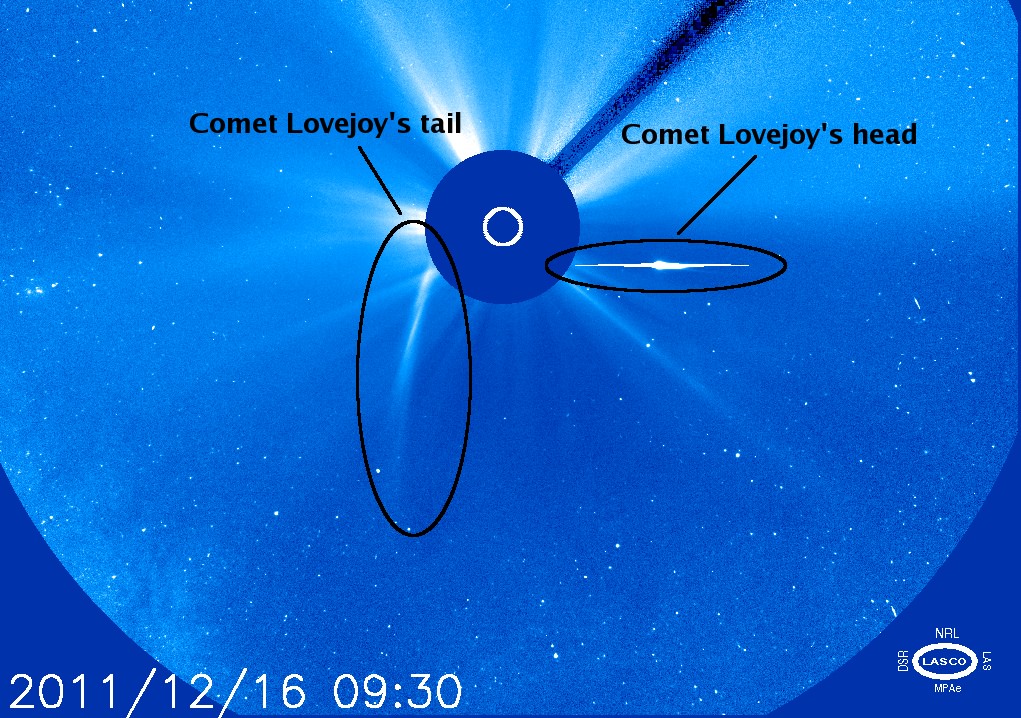It’s the morning after for the sungrazing Comet Lovejoy, and this feisty comet has scientists shaking their heads in disbelief. “I don’t know where to begin,” wrote Karl Battams, from the Naval Research Laboratory, who curates the Sun-grazing comets webpage. “What an extraordinary 24hrs! I suppose the first thing to say is this: I was wrong. Wrong, wrong, wrong. And I have never been so happy to be wrong!”
Many experts were predicting Comet Lovejoy would not survive perihelion, where it came within about 120,000 km from the Sun. But some extraordinary videos by NASA’s Solar Dynamics Observatory showed the comet entering and then surprisingly exiting the Sun’s atmosphere. Battams said he envisioned that if the comet survived at all, what would be left would be just a very diffuse component that would endure maybe a few hours after its close encounter with the Sun. But somehow it survived, even after enduring the several million-degree solar corona for nearly an hour. However, Comet Lovejoy appears to have lost its tail, as you can see in the image below.
[/caption]
The comet is now in the view of other spacecraft, which will continue monitoring the object. It will likely grow a “new” tail as outgassing of dust, gas and debris will continue. It is not known yet how much of Comet Lovejoy’s core remains — which was 200 meters in diameter earlier this week — or how long it will continue to stay together after its close brush with the Sun.
But we’ll keep you posted!
See more videos of Lovejoy’s survival below:


It was really cool to see all these ‘real-time’ news of the event. I keep refreshing my browser just to make sure I will not miss anything! Awesome 24hrs indeed!
The article doesn’t say how close it came to the sun. Does anyone know? I would have imagined that if it was too close, the intense gravity of the sun would have torn it to shreds.
Good point — I’ve added to the article that it was projected to come within about 120,000 km of the Sun.
Thanks
It DID say. 120000KM . READ the article, you can’t miss it. That’s pretty darn close. it’s around 72000 miles. So, less than 3 Earth Circumferences .. or about 9 Diameters. Or consider it as less than 1 Jovian Diameter.
It DIDNT say when I first READ the article. It was added later. No need to be rude about it.
Any word on the return trajectory, will it be a bright comet, visible where and when,,,,,,
Are we 100% sure this wasn’t Rama?
I simulated using astrograv.
It’s closets point would have been at 822,339 from the centre so about 126,339 km.
Its speed would have been 568.198 km/s
(Astrograv uses 1 AU = 149,597,870,700 meters
And Sun mass = 1.98891694291212*10^30 kg (the wikipedia number is rounded of)
So it seems that is speeded faster than Elenin and probably stayed much less time in the hot zone.
Good morning and thank you for the video’s
Although the “the comet has lost its tail” statement has me confused
For the last forty years I have been working under the assumption that a comets tail was the product of solar wind
And that the tail always faces away from the sun
Now after watching the vid’s ( more than once)
Am now correct in the view that as a comet passes through the solar atmosphere the tail becomes more of a contrail
Therefore as the comet moves further away from the sun its “normal ” tail will reappear again streaming away from the solar wind
Just asking just a sky watcher ( and endlessly curious )
H
Does anybody know if the comet is names after the Simpsons’ character Reverend Lovejoy?
Feisty “snowball” indeed.
Now I see what I’ve been missing by not checking my email……COMPLETE AWESOMENESS glad I caught this…..
From Belize
Denver. C